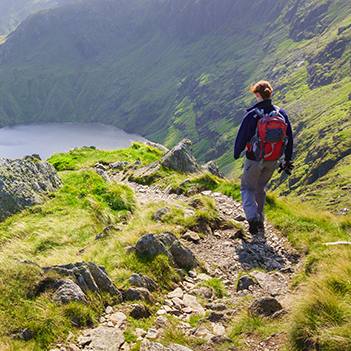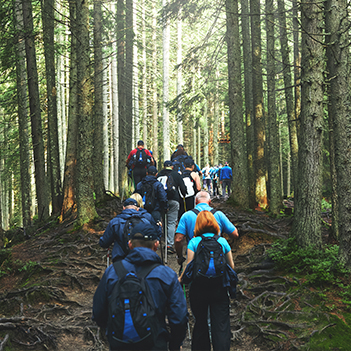Another Personal View
This is another personal view of the Wessex 100 written initially for a running club magazine. Thank you to Hilary Farren who has kindly agreed to let us see the article.
Wessex 100
The idea of undertaking a walk of 100 miles within 48 hours, over the late Bank Holiday in May, is not everyone’s idea of fun, but I enjoy it. And, it would seem, do another 400/450 other members of the Long Distance Walkers Association. Each year, this flagship event is organised by a different Local Group of the LDWA, this year, it was the turn of the Wessex Group and the event took place in the beautiful countryside around Hampshire.
The event was, as usual, perfectly organised and after checking in and leaving my breakfast bag for onward transmission to the breakfast stop at Rowlands Castle, I waited on the playing fields of Eggars School for the 10.00 a.m. start. The day promised to be warm and dry. The local press were around taking photos and the Mayor came to address us before we set off.
At 10.00 a.m. prompt we were off. From Alton the route headed roughly South East following part of Hangers Way to the first checkpoint at Selbourne. Being the first checkpoint it was very busy so I only had a quick drink before setting off for the checkpoint at Steep.
The route ascended a total of 1333 ft in just under 7 miles, mainly following the Hangers Way. The ground was very hard. The first day we headed south or east and the sun got hotter as the day progressed. I comforted myself with the thought that this would make the night sections easier.
From Steep the route followed Hangers Way again to Harting Down, checkpoint 3, at a distance of 21.6 miles it was clear from these first 21 miles that the route was taking us through the best that Hampshire had to offer; beautiful countryside, shady woods, quite country lanes. Occasionally, interested locals would ask what was going on, and how long was our walk. The reply was always met with queries as to where we would camp for the night. Many assumed we were doing this for charity, only to be told that no, we did it because we enjoyed it. It was fun.
At Harting Down there was plenty of refreshments and I made the most of the quiche and potato salad and tinned peaches, ready for the route along the South Downs Way to Heyshott. Although the day was extremely hot, the route took us along footpaths sheltered from the sun by trees and the walking was very pleasant. It was as I neared the checkpoint nearly 30 miles from the start that the first of the runners, who had left at 2.00 p.m. overtook me. I was to discover after the event that some of these runners had finished in under 24 hours!
From Heyshott we again followed for the most part the South Downs Way to checkpoint 5 at Sutton Village Hall. It had cooled considerably in the evening and had gone dark before I reached Sutton. Again, the checkpoint volunteers at Sutton were welcoming and encouraging and served us with food and drink to sustain us through the night section to the next checkpoint at Slindon.
I generally find navigation in the dark somewhat tricky, but the route description was so well written that it was not really a problem on this walk. I arrived at Slindon without encountering problems just after midnight. I was feeling somewhat weary on arrival but the marshalls at the checkpoint were wonderful and served me with food and hot tea before sending me on my way with words of encouragement.
The next section to East Dean at 47.2 miles was again undertaken in the dark. Again, the route took us through wooded areas, which was great in the daylight but really was too much of a good thing in the dark. Tree roots underfoot had to be avoided and way markers with 2 blue arrows referred to in the route description were difficult to find. However, just after 3.00 a.m. I arrived at East Dean checkpoint to a warm welcome and hot food.
I became increasingly tired but after leaving East Dean comforted myself with the knowledge that I would soon be half way round, and on the way back. It would soon be daylight again and my desire for sleep would disappear. The sun came up again, and the route took us past Goodwood Race Course up hill and along bridleways to the open air checkpoint at Stoughton Down. Large tents had been erected and the Marshalls were boiling water for tea and to cook hotdogs on stoves. Unfortunately, I didn’t eat as much as I should have done here and found the section to the breakfast stop at Rowlands Castle very difficult.
There was not much ascent on this section, just 430 foot and 6 miles, but I struggled to get there. I was feeling very week and weary and the sun was just too hot. Twice I had to stop just to rest. I felt an almost overwhelming desire to sleep. Encouraged by my friend, I made it to Rowlands Castle but not without thoughts of retirement uppermost in my mind.
However, the Breakfast stop is the checkpoint at which you can really refresh yourself. East Lancs Group have traditionally manned this checkpoint and the walker (and runner) is provided with pretty much whatever he wants; full English breakfast, cereal, porridge,toast, etc. Anyone who has entered the Two Crosses event will know that their catering and hospitality are second to none. A breakfast bag is also transported here from the start, providing an opportunity to change into fresh clothes. The bag is then taken back to the start with whatever may not be needed for the rest of the walk. I have always found this checkpoint to be good for morale and as on previous events I felt much better for being in clean clothes and having had breakfast. Although well past half way, at 60.9 miles, it is only on reaching this checkpoint that I really feel I am on the return leg. In the changing rooms I had the opportunity to talk to other ladies who it seems had also found the route there difficult and who had similar thoughts of retirement. Wishing each other well we left to continue on to the checkpoint at Queen Elizabeth Country Park.
The temperature continued to rise throughout the morning and the route took us up hill and along hard stony paths. I felt better than before but the going was hard. The route took us around a forest and a local beauty spot before we arrived at the checkpoint. “The Hut” behind the visitor centre had been made available for the checkpoint. Marshalls had been manning this checkpoint since 1.00 a.m.on Sunday to provide refreshments for us. I left there feeling much better than I had done for hours to cross under the A3 and up and over Butser Hill, which was not quite as difficult as it looked from a distance. However, at the top, for the first time on the walk, we lost our way. Somehow we missed the blue ringed South Downs Way sign post and found ourselves wandering around before bumping into another group who had also gone astray. After consulting the map we decided on a path which would take us down the other side, and once there were able to work out our position and find our way back on to the route description and finally to East Meon checkpoint.
From here the route followed the South Downs Way again, still heading West. The sun was again in front of us and the route took us uphill for most of the way. It became extremely hot and the checkpoint was some way off and over a big hill, but unexpectedly an impromptu drinks station had been set up by kindly volunteers serving cold water from the boot of their car. The next checkpoint was at the top of Beacon Hill reached after following a series of stiles ascending the hill. As I neared the top I found myself looking into the lense of a video camera – just what I wanted!
After 79.7 miles I reached checkpoint 12. A kindly marshall offered biscuits and cakes and drinks and assurances that the next checkpoint, only 2.2 miles away, was all downhill. He was right but by now it was becoming increasingly more difficult to set off again after resting at checkpoints as my muscles were beginning to seize up and my feet were aching. And so it took me about 1 and ¼ hours to cover the 2.2 miles to the checkpoint at Kilmeston manned by the Cornwall and Devon Group.
By now I had seriously considered retiring. The checkpoint however provided hot beans or spaghetti on toast and the helpers from Cornwall and Devon encouraged me to carry on, assuring me that I had done the worst of it, that navigation was straightforward and that there were no big hills. I wasn’t fully convinced that it was quite as easy as she made it sound and my pace had slowed to a crawl. She pointed out I had less than 20 miles to the finish. And so it was I found myself outside the checkpoint, checking the route to the next checkpoint at Old Arlesford.
This was in fact relatively straightforward, some of the route taking us through the town centre but then a rather circuitous route via some fields to the checkpoint at the village hall.
The next section to the checkpoint at Upper Wield was probably the most horrendous section of the whole 100 mile route. Whilst the route followed wide tracks it was treacherous underfoot, the tracks being covered in lose flints and stone, and deep tracks having been made either side by tractors or other four wheel drives. Navigation was quite easy but walking was painful and difficult and I seemed to take forever to reach the village hall. I regretted leaving Kilmeston but having walked 92.5 miles retiring now was out of the question. I began to think that there must be better ways of spending Bank Holiday weekends.
The stony tracks continued to the checkpoint at Shalden the last checkpoint at 97 miles. Although there were offers of hot tea and food I felt that the effort of getting up again and walking off the stiffness was too much to bear and in any case I was now desperate just to finish and to stop walking for good. So I just had my tally clipped and carried on immediately.
For a short section we walked along tarmac roads. Until this point, I had always failed to appreciate the sheer joy of walking on tarmac, preferring to walk off road whenever possible. However, now I realised that it was indeed a most pleasant experience, there were no more flints biting into my boots, no narrow ridges to balance along in the dark, no stones jumping up and ensconcing themselves firmly between sock and boot. It was however a short lived respite as the route took us over the main B3349 and up steps cut into the ground and along yet another stony track through woods until finally emerging into open fields. It seemed far longer than the 2.9 miles referred to in the route description, but finally the main London Road was in sight and 400 meters on was Eggars School and the finish. I was by now completely exhausted, the heat had taken its toll during the day, and the stony uneven tracks had been a nightmare in the dark. I think I only managed to continue to the end by promising myself that would be the last time I would do this event, I couldn’t really see the point any more.
And so, 42 hours and 39 minutes after setting off, I finished the walk. On entering the hall I was met with a heart warming round of applause from marshalls and others that had finished before me. There was then, as always, a hot meal and drink, and with the certificate and badge, I was given a map with next year’s route highlighted.
Whilst I found this one of the hardest 100s and probably the one I enjoyed the least, it was, as always, superbly organized. The route, whilst difficult underfoot, took us through wonderful countryside, the hospitality at the checkpoints was amazing. My thanks go to the organizers and to the marshalls who had given up their Bank Holiday weekend to make the event possible. Although I found it hard to keep going, it is after all a 100 mile challenge event, and as any long distance walker, or runner, will say it’s an event which challenges you more mentally than physically.
Now, of course, two weeks later, the memories have faded a little and I am left with the satisfaction of having finished another 100, and the thought that it was not that bad after all, and although I know it was, I also know that as soon as the entry forms for next year’s are out, I will send it off immediately.
Hilary Farren
Wessex 100
The idea of undertaking a walk of 100 miles within 48 hours, over the late Bank Holiday in May, is not everyone’s idea of fun, but I enjoy it. And, it would seem, do another 400/450 other members of the Long Distance Walkers Association. Each year, this flagship event is organised by a different Local Group of the LDWA, this year, it was the turn of the Wessex Group and the event took place in the beautiful countryside around Hampshire.
The event was, as usual, perfectly organised and after checking in and leaving my breakfast bag for onward transmission to the breakfast stop at Rowlands Castle, I waited on the playing fields of Eggars School for the 10.00 a.m. start. The day promised to be warm and dry. The local press were around taking photos and the Mayor came to address us before we set off.
At 10.00 a.m. prompt we were off. From Alton the route headed roughly South East following part of Hangers Way to the first checkpoint at Selbourne. Being the first checkpoint it was very busy so I only had a quick drink before setting off for the checkpoint at Steep.
The route ascended a total of 1333 ft in just under 7 miles, mainly following the Hangers Way. The ground was very hard. The first day we headed south or east and the sun got hotter as the day progressed. I comforted myself with the thought that this would make the night sections easier.
From Steep the route followed Hangers Way again to Harting Down, checkpoint 3, at a distance of 21.6 miles it was clear from these first 21 miles that the route was taking us through the best that Hampshire had to offer; beautiful countryside, shady woods, quite country lanes. Occasionally, interested locals would ask what was going on, and how long was our walk. The reply was always met with queries as to where we would camp for the night. Many assumed we were doing this for charity, only to be told that no, we did it because we enjoyed it. It was fun.
At Harting Down there was plenty of refreshments and I made the most of the quiche and potato salad and tinned peaches, ready for the route along the South Downs Way to Heyshott. Although the day was extremely hot, the route took us along footpaths sheltered from the sun by trees and the walking was very pleasant. It was as I neared the checkpoint nearly 30 miles from the start that the first of the runners, who had left at 2.00 p.m. overtook me. I was to discover after the event that some of these runners had finished in under 24 hours!
From Heyshott we again followed for the most part the South Downs Way to checkpoint 5 at Sutton Village Hall. It had cooled considerably in the evening and had gone dark before I reached Sutton. Again, the checkpoint volunteers at Sutton were welcoming and encouraging and served us with food and drink to sustain us through the night section to the next checkpoint at Slindon.
I generally find navigation in the dark somewhat tricky, but the route description was so well written that it was not really a problem on this walk. I arrived at Slindon without encountering problems just after midnight. I was feeling somewhat weary on arrival but the marshalls at the checkpoint were wonderful and served me with food and hot tea before sending me on my way with words of encouragement.
The next section to East Dean at 47.2 miles was again undertaken in the dark. Again, the route took us through wooded areas, which was great in the daylight but really was too much of a good thing in the dark. Tree roots underfoot had to be avoided and way markers with 2 blue arrows referred to in the route description were difficult to find. However, just after 3.00 a.m. I arrived at East Dean checkpoint to a warm welcome and hot food.
I became increasingly tired but after leaving East Dean comforted myself with the knowledge that I would soon be half way round, and on the way back. It would soon be daylight again and my desire for sleep would disappear. The sun came up again, and the route took us past Goodwood Race Course up hill and along bridleways to the open air checkpoint at Stoughton Down. Large tents had been erected and the Marshalls were boiling water for tea and to cook hotdogs on stoves. Unfortunately, I didn’t eat as much as I should have done here and found the section to the breakfast stop at Rowlands Castle very difficult.
There was not much ascent on this section, just 430 foot and 6 miles, but I struggled to get there. I was feeling very week and weary and the sun was just too hot. Twice I had to stop just to rest. I felt an almost overwhelming desire to sleep. Encouraged by my friend, I made it to Rowlands Castle but not without thoughts of retirement uppermost in my mind.
However, the Breakfast stop is the checkpoint at which you can really refresh yourself. East Lancs Group have traditionally manned this checkpoint and the walker (and runner) is provided with pretty much whatever he wants; full English breakfast, cereal, porridge,toast, etc. Anyone who has entered the Two Crosses event will know that their catering and hospitality are second to none. A breakfast bag is also transported here from the start, providing an opportunity to change into fresh clothes. The bag is then taken back to the start with whatever may not be needed for the rest of the walk. I have always found this checkpoint to be good for morale and as on previous events I felt much better for being in clean clothes and having had breakfast. Although well past half way, at 60.9 miles, it is only on reaching this checkpoint that I really feel I am on the return leg. In the changing rooms I had the opportunity to talk to other ladies who it seems had also found the route there difficult and who had similar thoughts of retirement. Wishing each other well we left to continue on to the checkpoint at Queen Elizabeth Country Park.
The temperature continued to rise throughout the morning and the route took us up hill and along hard stony paths. I felt better than before but the going was hard. The route took us around a forest and a local beauty spot before we arrived at the checkpoint. “The Hut” behind the visitor centre had been made available for the checkpoint. Marshalls had been manning this checkpoint since 1.00 a.m.on Sunday to provide refreshments for us. I left there feeling much better than I had done for hours to cross under the A3 and up and over Butser Hill, which was not quite as difficult as it looked from a distance. However, at the top, for the first time on the walk, we lost our way. Somehow we missed the blue ringed South Downs Way sign post and found ourselves wandering around before bumping into another group who had also gone astray. After consulting the map we decided on a path which would take us down the other side, and once there were able to work out our position and find our way back on to the route description and finally to East Meon checkpoint.
From here the route followed the South Downs Way again, still heading West. The sun was again in front of us and the route took us uphill for most of the way. It became extremely hot and the checkpoint was some way off and over a big hill, but unexpectedly an impromptu drinks station had been set up by kindly volunteers serving cold water from the boot of their car. The next checkpoint was at the top of Beacon Hill reached after following a series of stiles ascending the hill. As I neared the top I found myself looking into the lense of a video camera – just what I wanted!
After 79.7 miles I reached checkpoint 12. A kindly marshall offered biscuits and cakes and drinks and assurances that the next checkpoint, only 2.2 miles away, was all downhill. He was right but by now it was becoming increasingly more difficult to set off again after resting at checkpoints as my muscles were beginning to seize up and my feet were aching. And so it took me about 1 and ¼ hours to cover the 2.2 miles to the checkpoint at Kilmeston manned by the Cornwall and Devon Group.
By now I had seriously considered retiring. The checkpoint however provided hot beans or spaghetti on toast and the helpers from Cornwall and Devon encouraged me to carry on, assuring me that I had done the worst of it, that navigation was straightforward and that there were no big hills. I wasn’t fully convinced that it was quite as easy as she made it sound and my pace had slowed to a crawl. She pointed out I had less than 20 miles to the finish. And so it was I found myself outside the checkpoint, checking the route to the next checkpoint at Old Arlesford.
This was in fact relatively straightforward, some of the route taking us through the town centre but then a rather circuitous route via some fields to the checkpoint at the village hall.
The next section to the checkpoint at Upper Wield was probably the most horrendous section of the whole 100 mile route. Whilst the route followed wide tracks it was treacherous underfoot, the tracks being covered in lose flints and stone, and deep tracks having been made either side by tractors or other four wheel drives. Navigation was quite easy but walking was painful and difficult and I seemed to take forever to reach the village hall. I regretted leaving Kilmeston but having walked 92.5 miles retiring now was out of the question. I began to think that there must be better ways of spending Bank Holiday weekends.
The stony tracks continued to the checkpoint at Shalden the last checkpoint at 97 miles. Although there were offers of hot tea and food I felt that the effort of getting up again and walking off the stiffness was too much to bear and in any case I was now desperate just to finish and to stop walking for good. So I just had my tally clipped and carried on immediately.
For a short section we walked along tarmac roads. Until this point, I had always failed to appreciate the sheer joy of walking on tarmac, preferring to walk off road whenever possible. However, now I realised that it was indeed a most pleasant experience, there were no more flints biting into my boots, no narrow ridges to balance along in the dark, no stones jumping up and ensconcing themselves firmly between sock and boot. It was however a short lived respite as the route took us over the main B3349 and up steps cut into the ground and along yet another stony track through woods until finally emerging into open fields. It seemed far longer than the 2.9 miles referred to in the route description, but finally the main London Road was in sight and 400 meters on was Eggars School and the finish. I was by now completely exhausted, the heat had taken its toll during the day, and the stony uneven tracks had been a nightmare in the dark. I think I only managed to continue to the end by promising myself that would be the last time I would do this event, I couldn’t really see the point any more.
And so, 42 hours and 39 minutes after setting off, I finished the walk. On entering the hall I was met with a heart warming round of applause from marshalls and others that had finished before me. There was then, as always, a hot meal and drink, and with the certificate and badge, I was given a map with next year’s route highlighted.
Whilst I found this one of the hardest 100s and probably the one I enjoyed the least, it was, as always, superbly organized. The route, whilst difficult underfoot, took us through wonderful countryside, the hospitality at the checkpoints was amazing. My thanks go to the organizers and to the marshalls who had given up their Bank Holiday weekend to make the event possible. Although I found it hard to keep going, it is after all a 100 mile challenge event, and as any long distance walker, or runner, will say it’s an event which challenges you more mentally than physically.
Now, of course, two weeks later, the memories have faded a little and I am left with the satisfaction of having finished another 100, and the thought that it was not that bad after all, and although I know it was, I also know that as soon as the entry forms for next year’s are out, I will send it off immediately.
Hilary Farren







